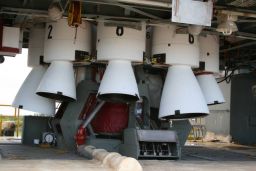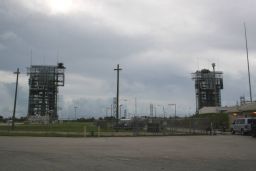Emily Lakdawalla • Sep 27, 2007
Dawn launch: T minus 1 day: Up close at the Delta II launch pad
Planetary Society volunteer Ken Kremer is reporting for us from the Kennedy Space Center, where he is anticipating the launch of Dawn on September 26. Kremer is a research scientist who spends his spare time giving public outreach presentations on behalf of The Planetary Society as a volunteer and NASA's Jet Propulsion Laboratory as a Solar System Ambassador. Thanks Ken! --ESL
 by Ken Kremer
by Ken Kremer
Today I stood just inches away from a Delta II rocket at Launch Complex 17 at Cape Canaveral Air Force Station (CCAFS), adjacent to the Kennedy Space Center. It's the thrill of a lifetime to witness history up close and personal at T minus 1 day on a mission designed to unlock the mysteries of the formation of our Solar System. And this is not a toy. It's the real deal loaded with dangerous propellants that can kill in an instant if mishandled. Yet it carries the dreams of scientists, engineers and just plain folks worldwide with the promise of a brighter future ahead. That's why we explore.Dawn will launch from Pad 17 B on a million pounds of thrust. Her eight-year journey culminates at the icy dwarf planet Ceres, for the first detailed investigations of the two most massive worlds in the asteroid belt. Many of NASA's planetary and earth observation satellites are launched on board the highly reliable Delta II rockets. Most recently the Phoenixmission, which will land at the north polar region of Mars and which will touch and sample martian water ice for the first time. My tour of the Delta II launch facility was graciously arranged by Craig Covault, Senior Editor of Aviation Week & Space Technology magazine and by United Launch Alliance which operates the Delta launch vehicle programs, and to whom I am thankful. Following is a photo album of my tour.

First stage nozzles on the Delta II: Ground-lit nozzles (white) are smaller diameter. Extended air-lit nozzles (white) are wider in diameter. First stage engine (Rocketdyne RS-27A) is protected by red shroud. Credit: Ken Kremer
Another busy day at the Cape at T minus 1 day from launch.
Support our core enterprises
Your support powers our mission to explore worlds, find life, and defend Earth. You make all the difference when you make a gift. Give today!
Donate

 Explore Worlds
Explore Worlds Find Life
Find Life Defend Earth
Defend Earth


